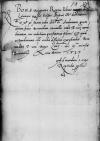Letter #1815
Bona Sforza to Ioannes DANTISCUSCracow (Kraków), 1537-12-03
| received [1537]-12-20 Manuscript sources:
| ||||
Text & apparatus & commentary Plain text Text & commentary Text & apparatus
Reverendissi paper damaged⌈[Reverendissi]Reverendissi paper damaged⌉mo in Christo Patri,
Reverende in Christo Pater, sincere nobis dilecte.
Audivimus grato animo hunc
Bene valeat Paternitas Vestra.
Dat(ae) or Dat(um)⌈Dat(ae)Dat(ae) or Dat(um)⌉
Ad mandatum s(acrae) or s(erenissimae)⌈s(acrae)s(acrae) or s(erenissimae)⌉ reginalis maiestatis proprium


 BCz, 3465, p. 276
BCz, 3465, p. 276